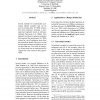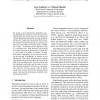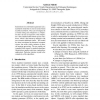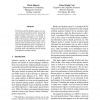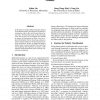NAACL
2010
13 years 9 months ago
2010
Several methods for automatically generating labeled examples that can be used as training data for WSD systems have been proposed, including a semisupervised approach based on re...
NAACL
2010
13 years 9 months ago
2010
Current vector-space models of lexical semantics create a single "prototype" vector to represent the meaning of a word. However, due to lexical ambiguity, encoding word ...
NAACL
2010
13 years 9 months ago
2010
We present a novel deterministic dependency parsing algorithm that attempts to create the easiest arcs in the dependency structure first in a non-directional manner. Traditional d...
NAACL
2010
13 years 9 months ago
2010
There are many misconceptions about dependency representations and phrase structure representations for syntax. They are partly due to terminological confusion, partly due to a la...
NAACL
2010
13 years 9 months ago
2010
Synchronous tree substitution grammars are a translation model that is used in syntax-based machine translation. They are investigated in a formal setting and compared to a compet...
NAACL
2010
13 years 9 months ago
2010
We are interested in diacritizing Semitic languages, especially Syriac, using only diacritized texts. Previous methods have required the use of tools such as part-of-speech tagger...
NAACL
2010
13 years 9 months ago
2010
The Brown and the Berkeley parsers are two state-of-the-art generative parsers. Since both parsers produce n-best lists, it is possible to apply reranking techniques to the output...
NAACL
2010
13 years 9 months ago
2010
This paper proposes a novel approach to the problem of training classifiers to detect and correct grammar and usage errors in text by selectively introducing mistakes into the tra...
NAACL
2010
13 years 9 months ago
2010
In a supertagging task, sequence labeling models are commonly used. But their limited ability to model long-distance information presents a bottleneck to make further improvements...
NAACL
2010
13 years 9 months ago
2010
In this paper we examine different linguistic features for sentimental polarity classification, and perform a comparative study on this task between blog and review data. We found...
